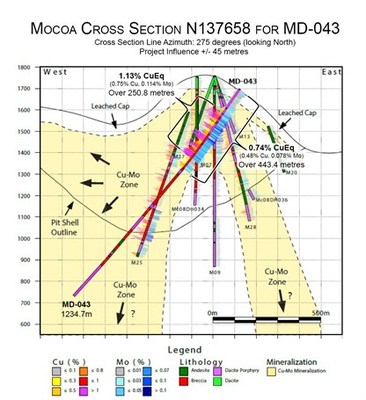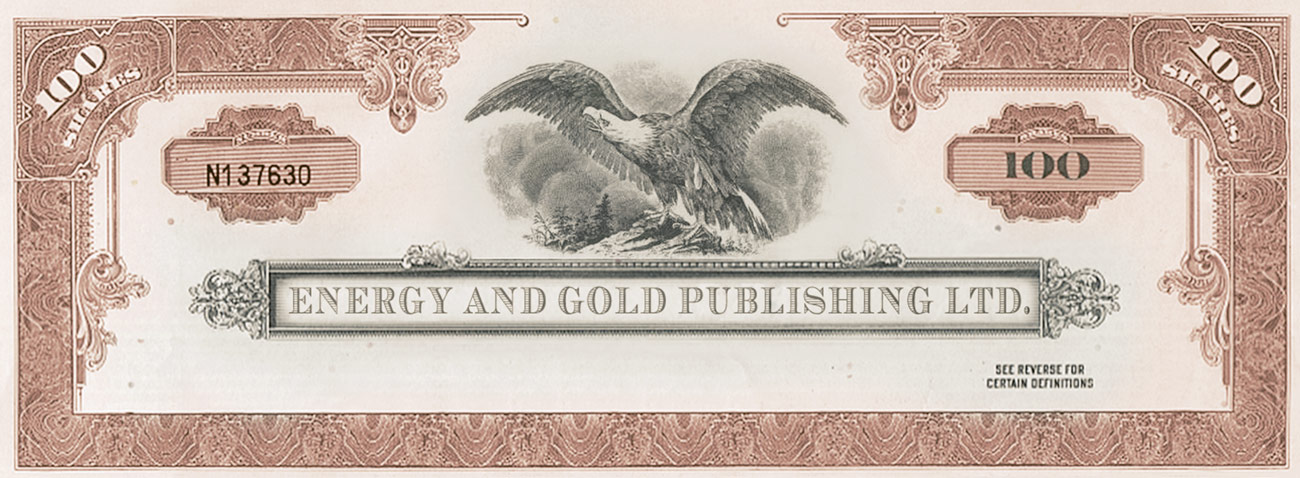VANCOUVER, BC, April 19, 2022 /CNW/ – Libero Copper & Gold Corporation (TSXV: LBC) (OTCQB: LBCMF) (DE:29H) is pleased to announce the initial partial assay results from the first diamond drill hole by Libero Copper (MD-043) into the Mocoa porphyry copper deposit located in Putumayo, Colombia. Drill hole MD-043 has been completed to a depth of 1,235 metres and significant assay results have been received and are reported here to a down hole depth of 450 metres.Highlights
- 443 meters of 0.74% CuEq1 (0.48% Cu and 0.078% Mo) from 7 to 450 metres, including
- 342 metres of 0.91% CuEq1 (0.60% Cu and 0.093% Mo) from 108 to 450 metres, including
- 251 metres of 1.13% CuEq1 (0.75% Cu and 0.114% Mo) from 139 to 390 metres
- Drill hole MD-043 reached a depth of 1,235 metres with assays pending for the remaining 785 metres of core
- Broad intercepts of copper and molybdenum mineralization continues well beyond the 450 meters of assay results reported in this news release
Composite assay intervals for copper and molybdenum to date for hole MD-043 to a depth of 450 metres are presented in Table 1.
| Interval | From (m) | To(m) | Interval (m) | Cu % | Mo % | CuEq1 % | ||||||
| 7.00 | 450.40 | 443.40 | 0.48 | 0.078 | 0.74 | |||||||
| incl. | 108.12 | 450.40 | 342.28 | 0.60 | 0.093 | 0.91 | ||||||
| incl. | 139.62 | 390.40 | 250.78 | 0.75 | 0.114 | 1.13 | ||||||
| and incl. | 145.40 | 178.82 | 33.42 | 0.90 | 0.096 | 1.22 | ||||||
| and incl. | 211.85 | 230.26 | 18.41 | 0.88 | 0.125 | 1.30 | ||||||
| and incl. | 242.26 | 295.90 | 53.64 | 0.92 | 0.152 | 1.43 | ||||||
| and, and incl. | 265.31 | 295.90 | 30.59 | 1.30 | 0.184 | 1.92 | ||||||
| and incl. | 309.40 | 390.40 | 81.00 | 0.82 | 0.090 | 1.12 | ||||||
| and, and incl. | 361.90 | 390.40 | 28.50 | 1.30 | 0.093 | 1.61 |
| 1 | Libero Copper defines copper equivalent calculation for reporting purposes only. Copper-equivalence calculated as: CuEq (%) = Cu (%) + 3.33 × Mo (%), utilizing metal prices of Cu – US$3.00/lb, Mo – US$10.00/lb. No adjustments were made for metal recovery. |
Table 1: Composite assay intervals for drill hole MD-043 to 450m.
“Hole MD-043 is starting to demonstrate the real potential of the Mocoa porphyry copper and molybdenum deposit with assay results returned to date confirming the exceptional grade, thickness and strength of the mineralizing system present in the area. The mineralized system remains open and many other porphyry targets have been identified for systematic follow-up within Libero Copper’s significant land position,” comments Ian Harris, President & CEO. “The Mocoa resource is already the largest copper resource in Colombia and will play a key role in the country’s goals of becoming the third largest producer of copper in South America, a metal that is indispensable in the decarbonization of the world’s economy.”
In drill hole MD-043, highly elevated copper – molybdenum mineralization occurs below the leached cap starting at a depth of 108 metres. The majority of the lithologies intersected in the hole consist of brecciated dacite porphyry which is overprinted by multiple phases of alteration, veining and mineralization with the original rock type typically unrecognizable due to hydrothermal alteration related to the mineralizing system. Phyllic alteration is typically overprinted by variable potassic alteration and is accompanied with multiple generations of quartz veining. Copper in the form of chalcopyrite, bornite and chalcocite and molybdenum in the form of molybdenite typically occur with quartz veins and as disseminations replacing variably altered rocks. Higher grade mineralized intervals typically contain strong potassic alteration overprinting highly obscured multi-phase quartz vein and silica rich porphyry breccia. Similar brecciated porphyry and alteration along with variable quartz-copper-molybdenite veining and mineralization continue in the hole well below the sample interval reported in this news release. Additional drilling will continue to confirm and expand the mineralizing system and confirm the geometry and nature of the mineralization remaining within the leached cap.
Copper and molybdenum grades are illustrated as histograms on the cross section illustrated in Figure 1, and Photos 1 and 2 are presented as representations of mineralization intersected at 229 metres and 270 metres respectively. Figure 1 is a cross section through hole MD-043 oriented 275 degrees looking north with a projection influence of +/- 45 metres. Simplified lithologies are plotted down the hole trace with copper and molybdenum histograms plotted along the left and right side of the hole trace respectively. An interpretation of the mineralized copper-molybdenum zone is illustrated, and the projected pit shell is illustrated as defined in the November 1, 2021 NI 43-101 Technical Report2. Table 2 contains select composite samples for the drill holes within the cross section.




About the Mocoa Porphyry Copper-Molybdenum Deposit
The Mocoa deposit is located in the department of Putumayo, 10 kilometres from the town of Mocoa and was discovered in 1973 when the United Nations and the Colombian government conducted a regional stream sediment geochemical survey. Between 1978 and 1983, an exploration program was carried out that consisted of geological mapping, surface sampling, ground geophysics (IP, magnetics), 31 diamond drill holes totaling 18,321 metres and metallurgical test work cumulating in a positive pre-feasibility study (the pre-feasibility study is historical in nature only and should not be relied upon as it is not NI 43-101 compliant). B2Gold subsequently executed diamond drill programs in 2008 and 2012.
A pit constrained inferred resource at Mocoa contains 636 million tonnes of 0.45% copper equivalent (0.33% Cu and 0.036% Mo)1 generated using $3/lb Cu and $10/lb Mo, containing 4.6 billion pounds of copper and 511 million pounds of molybdenum. The Mocoa deposit appears to be open in both directions along strike and at depth. Current work on the property has identified additional porphyry targets including the possible expansion of known mineralization which will receive additional follow-up drilling in 2022.
The Mocoa deposit is situated in the Eastern Cordillera of Colombia, a 30-kilometre-wide tectonic belt
underlain by volcano-sedimentary, sedimentary and intrusive rocks that range in age from Triassic-Jurassic to Quaternary and by remnants of Paleozoic metasediments and metamorphic rocks of Precambrian age. This belt hosts several other porphyry-copper deposits in Ecuador, such as Mirador (438 million tonnes measured and indicated at 0.61% Cu and 235 million tonnes inferred at 0.52% Cu)3, San Carlos (600 million tonnes inferred at 0.59% Cu)3, Panantza (463 million tonnes inferred at 0.66% Cu)4 and Solaris’ Waritza, located in Ecuador.
Copper-molybdenum mineralization is associated with dacite porphyry intrusions of the Middle Jurassic age that are emplaced into andesitic and dacitic volcanics. The Mocoa porphyry system exhibits a classical zonal pattern of hydrothermal alteration and mineralization, with a deeper central core of potassic alteration overlain by sericitization and surrounded by propylitization. Mineralization consists of disseminated chalcopyrite, molybdenite and local bornite and chalcocite associated with multiphase veins, stockwork and hydrothermal breccias. The Mocoa deposit is roughly cylindrical, with a 600 metre diameter. High-grade copper-molybdenum mineralization continues to depths in excess of 1,000 metres.
_________________________
| 2 | Technical Report “Mocoa Copper-Molybdenum Project” dated effective November 1, 2021 |
| 3 | Technical Report: “Mirador Copper-Gold Project 30,000 TPD Feasibility Study” dated effective April 3, 2008 |
| 4 | Technical Report: “Preliminary Assessment Report Panantza & San Carlos Copper Project” dated effective October 30, 2007 |
Quality Assurance / Quality Control on Sample Collection, Security and Assaying
Libero Copper operates according to a rigorous Quality Assurance and Quality Control (QA/QC) protocol consistent with industry best practices. Primary sample collection involves secure transport from Libero Copper’s core logging facilities in Mocoa, Colombia to the ActLabs certified sample preparation facility in Medellin, Colombia. Samples are processed in the Medellin facilities where they are analyzed for copper and molybdenum by 4-Acid digest AA analysis. The sample pulps are air freighted from Medellin to the ActLabs certified laboratory in Guadalajara, Mexico, where they are analyzed using 4-Acid digest ICP multi element analysis.
In order to monitor the ongoing quality of assay data and the database, Libero Copper has implemented QA/QC protocols which include standard sampling methodologies, the insertion of certified standard materials, blanks and field duplicates and ongoing monitoring of data entry, QA/QC reporting and data validation. No material QA/QC issues have been identified with respect to sample collection, security and assaying.Qualified Person
Information in this news release relating to the exploration results is based on data reviewed by Matthew C. Wunder, B.Sc. P.Geo., the Vice President Exploration for Libero Copper. Mr. Wunder is a registered Professional Geologist and has in excess of 35 years’ experience in mineral exploration and is a Qualified Person as defined under National Instrument 43-101. About Libero Copper & Gold
Libero Copper is unlocking the value of a collection of porphyry copper deposits throughout the Americas in prolific and stable jurisdictions. The portfolio includes the Mocoa deposit in Putumayo, Colombia; Esperanza in San Juan, Argentina; and Big Red and Big Bulk in the Golden Triangle, BC, Canada. These assets are being advanced by a highly disciplined and seasoned professional team with successful track records of discovery, resource development, and permitting in the Americas.
Neither the TSX Venture Exchange nor its Regulation Services Provider (as that term is defined in the policies of the TSX Venture Exchange) accepts responsibility for the adequacy or accuracy of this release. This news release includes forward-looking statements that are subject to risks and uncertainties. All statements within, other than statements of historical fact, are to be considered forward looking. Although the Company believes the expectations expressed in such forward-looking statements are based on reasonable assumptions, such statements are not guarantees of future performance and actual results or developments may differ materially from those in forward-looking statements. Factors that could cause actual results to differ materially from those in forward-looking statements include market prices, exploitation and exploration successes, continued availability of capital and financing, and general economic, market or business conditions and regulatory and administrative approvals, processes and filing requirements. There can be no assurances that such statements will prove accurate and, therefore, readers are advised to rely on their own evaluation of such uncertainties. We do not assume any obligation to update any forward-looking statements.

SOURCE Libero Copper & Gold Corporation.

![]() View original content to download multimedia: http://www.newswire.ca/en/releases/archive/April2022/19/c1576.html
View original content to download multimedia: http://www.newswire.ca/en/releases/archive/April2022/19/c1576.html
